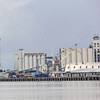DP World's Plan to Tackle Africa's Infrastructure Gap
A five point plan to help tackle Africa’s infrastructure gap is among the findings of a new DP World report to be unveiled at the Africa Global Business Forum this week.
Public private partnerships, domestic bond financing, monitoring the life cycle of infrastructure by maintaining and upgrading existing stock, enhanced trade integration and improved trade facilitation are key points raised in the study “Africa At The Crossroads: Bridging The Infrastructure Gap” produced in association with the Economist Intelligence Unit.
Over the past decade, investment in African infrastructure has risen sharply and some notable projects have been completed. But despite the impressive flow of projects and policy reforms, the continent’s infrastructure development has failed to keep up with the average annual GDP growth of 5%. The development of “soft” infrastructure, such as the legal and regulatory frameworks that enable physical infrastructure to be built and maintained, has also fallen short of requirements.
The report traces the continent’s strong economic growth in recent years and highlights how infrastructure development has not kept pace, placing an increasing strain on existing infrastructure assets.
To overcome infrastructure deficits on the continent, as much as US $93 billion will be required annually (approximately 10% of African GDP), with only half of that amount currently available, the report explains.
DP World Chairman HE Sultan Ahmed Bin Sulayem said, “African countries need a solid foundation on which to place the building blocks of their economies. Both soft and hard infrastructure is needed, which will determine how quickly physical assets are built and how quickly trade develops.
“Our ports in Africa have shown us how the region has enjoyed strong growth over the last 10 years, leading to rising incomes, falling poverty and a step toward economic diversification. However, all this has also placed an increasing strain on existing inland and marine infrastructure. If Africa’s countries and regions were better connected, market sizes would increase and encourage greater foreign investment.”
Yet while Sub-Saharan Africa currently spends around US $6.8 billion per year on paving roads, this figure needs to be closer to US $10 billion.
HE Bin Sulayem stressed the significance of the Public-Private Partnerships (PPP) model, explaining how several African governments have already started to design policies to accelerate infrastructure projects.
Referring to report findings, he added: “PPPs are an increasingly popular model to fund projects and the regulatory frameworks supporting them are improving. In addition, resource-rich countries are using their commodities as leverage to obtain infrastructure investment. Today, a growing number of the new natural resource contracts that African governments hand out have an ‘infrastructure industrialisation’ component – requiring the company in question to invest in new infrastructure."
DP World has long advocated the power of partnership, having agreements with governments in all six of its ports in five African countries. Africa is a key market in DP World’s network, where it employs over 5,000 people and has established strong community ties, while creating jobs and opportunities for local businesses.
The report also finds that to address the soft infrastructure gap, better internal trade integration is key. One solution to encourage intra-African trade would be to create a pan-Africa free trade agreement, which has already been proposed.
The paper concludes that growth in Africa brings new challenges and current evidence suggests that the African continent is moving at a rate with which its infrastructure cannot keep up. There are encouraging signs of world-class infrastructure delivery on the continent, like South Africa’s Gautrain rapid rail transit system and Kenya’s new railway connecting Nairobi with Mombasa.
Other high impact projects underway could also be game-changers if they can overcome operational challenges. A notable example is the Inga Dam in the Democratic Republic of Congo.
Meanwhile, a range of policies from regional free trade agreements to improved PPP frameworks across a large number of countries are starting to happen, which suggests that the enabling environment for infrastructure development is improving. If momentum can be maintained and accelerated, then it could help the continent overcome its critical deficits and seize the economic transformation that now lies within its grasp.
The DP World report “Africa At The Crossroads: Bridging The Infrastructure Gap” can be accessed on DP World website: www.dpworld.com












